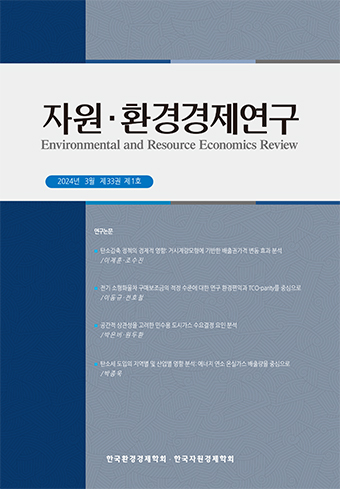Research Paper
Abstract
References
Information
This study investigates the convergence in per capita CO2 emission by income group for an unbalanced panel of 152 countries from 1980 to 2013 using beta and sigma convergence model. Absolute beta and sigma convergence differed by CO2 emission reduction policies in each countries. Conditional beta convergence shows that per capita income has a negative effect on growth in per capita CO2 emission. In particular, better-quality institutions and technology accelerated the negative effect of per capita income on the speed of convergence of per capita CO2 emission in high-income countries. For middle-income countries, the growth of income affected the convergence of CO2 emission per capita, but institutional quality has an insignificant impact. On the other hand, improvements in the level of technology have a mitigating effect on the negative impact of income in middle-income and low-income countries, contributing to the increase in CO2 emission.
본 연구는 152개 국가의 불균형 패널 자료를 활용하여 1980~2013년 기간의 국가별 소득수준에 따른 1인당 CO2 배출 수렴 현상을 시그마 수렴 모형과 베타 수렴 모형을 통해 분석하였다. 절대적 베타 수렴과 시그마 수렴 현상은 CO2 배출 감축을 위한 국가별 정책 상황에 따라 소득 그룹별로, 기간별로 상이하게 나타났다. 조건부 베타 수렴 분석 결과, 고소득 국가에서 1인당 소득의 증가가 1인당 CO2 배출량 수렴에 기여하였으며 제도의 수준과 기술의 수준이 높을수록 소득의 증가가 배출량 수렴 속도를 더 빠르게 감소시키는 것으로 나타났다. 중소득 국가는 1인당 소득의 증가가 1인당 CO2 배출량 수렴에 영향을 미쳤으나, 제도의 수준은 유의미하지 않게 나타났다. 반면 중소득 국가와 저소득 국가의 기술 수준 향상은 1인당 CO2 배출량 수렴 속도를 늦추는 것으로 나타나 배출량 증가에 기여하는 것으로 분석되었다.
- 조성택‧조용성, “이산화탄소 배출량의 수렴성 검정: 다이나믹 패널 분석과 패널 단위근 검정을 이용하여”, 「자원‧환경경제연구」, 제18권 제1호, 2009, pp. 53~75.
- 김지욱, “아시아 국가들 환경오염배출량의 확률수렴성과 환경쿠즈네츠곡선가설 검정”, 「자원‧환경경제연구」, 제19권 제3호, 2010, pp. 571~598.
- 김지욱, “경제성장과 환경오염 간의 비선형 및 수렴성 검정”, 「한국경제연구」, 제31권 제3호, 2013, pp. 239~266.
- 김재혁‧조하현, “1인당 탄소배출 수렴가설 검정: 105개국 동태적 패널임계 분석”, 「국제통상연구」, 제22권 제1호, 2017, pp. 123~154.
- 대외정책연구원, 『기후변화협상의 국제적 동향과 시사점』, 2009.
- 에너지경제연구원, 『새로운 기후체제에 대한 주요국의 입장』, 2009.
- 에너지경제연구원, 『세계에너지시장인사이트』, 제17-7호, 2017.
- 환경부, 『교토의정서 이후 신 기후체제 파리협정 길라잡이』, 2016.
- Aghion, P., and P. Howitt, Endogenous Growth Theory, Cambridge MA, 1998.
- Aldy, J. E., “Per Capita Carbon Dioxide Emissions: Convergencfe or Divergence?,” Environmental and Resource Economics, Vol. 33, No. 4, 2006, pp. 533~555.10.1007/s10640-005-6160-x
- Barro, R. J., and X. Sala-i-Martin, “Convergence Across States and Regions,” Brookings Paper on Economics Activity, Vol. 1991, No. 1, 1991, pp. 107~182.10.2307/2534639
- Barro, R. J., and X. Sala-i-Martin, “Convergence,” Journal of Political Economy, Vol. 100, No. 2, 1992, pp. 223~251.10.1086/261816
- Barro, R. J., and X. Sala-i-Martin, “The Classical Approach to Convergence Analysis,” The Economic Journal, Vol. 106, No. 437, 1996, pp. 1019~1036.10.2307/2235375
- Baumol, W. J., “Productivity Growth, Convergence, and Welfare: What the Long-Run Data Show,” American Economic Review, Vol. 76, No. 5, 1986, pp. 1072~1085.
- Brock, W. A., and M. S. Taylor, “The kindergarten rule of sustainable growth,” NBER Working Paper, No. 9597, 2003.
- Brock, W. A., and M. S. Taylor, “The Green Solow model,” NBER Working Paper, 2004a.
- Brock, W. A., and M. S. Taylor, “Economic growth and the Environment: A Review of Theory and Empirics,” NBER Working Paper, 2004b.
- Brock, W. A., and M. S. Taylor, “The Green Solow Model,” Journal of Economic Growth, Vol. 15, No. 2, 2010, pp. 127~153.10.1007/s10887-010-9051-0
- Camarero, M., A. J. Picazo-Tadeo, and C. Tamarit, “Are the Determinants of CO2 Emissions Converging among OECD Countries?,” Economics Letters, Vol. 118, No. 1, 2013a, pp. 159~162.10.1016/j.econlet.2012.10.009
- IEA, CO2 Emissions from Fuel Combustion, 2016.
- Jobert, T., F. Karanfil, and A. Tykhonenko, “Convergence of per capita carbon dioxide emissions in the EU: Legend or reality?,” Energy Economics, Vol. 32, No. 6, 2010, pp. 1364~1373.10.1016/j.eneco.2010.03.005
- Mckibbin, W. J. and A. Stegman, “Convergence and Per Capita Carbon Emissions,” Brookings Discussion Papers in International Economics, No. 167, 2005.
- Nguyen Van, P., “Distribution Dynamics of CO2 Emissions,” Environmental and Resource Economics, Vol. 32, No. 4, 2005, pp. 495~508.10.1007/s10640-005-7687-6
- Panopoulou, E. and T. Pantelidis, “Club Convergence in Carbon Dioxide Emissions,” Environmental and Resource Economics, Vol. 44, No. 1, 2009, pp. 47~70.10.1007/s10640-008-9260-6
- Pettersson, F., D. Maddison, S. Acar, and R. Söderholm, “Convergence of Carbon Dioxide Emissions: A Review of the Literature,” International Review of Environmental and Resource Economics, Vol. 7, No. 2, 2014, pp. 141~178.10.1561/101.00000059
- Runar, B., K. Amin, and S, Patrik, “Convergence in Carbon Dioxide Emissions and the Role of Growth and Institutions: A Parametric and Nonparametric analysis,” Environmental and Policy Studies, Vol. 19, No. 2, 2017, pp. 359~390.10.1007/s10018-016-0162-5
- Sala-i-Martin, X., “The Classical Approach to Convergence Analysis,” The Economic Journal, Vol. 106, No. 437, 1996, pp. 1019~1036.10.2307/2235375
- Solow, R. M., “A Contribution to the Theory of Economic Growth,” Quarterly Journal of Economics, Vol. 70, No. 1, 1956, pp. 65~94.10.2307/1884513
- Swan, T. W., “Economic Growth and Capital Accumulation,” Economic Record, Vol. 32, No. 2, 1956, pp. 334~361.10.1111/j.1475-4932.1956.tb00434.x
- Stokey, N. L., “Are there Limits to Growth?,” International Economic Review, Vol. 39, No. 1, 1998, pp. 1-31.10.2307/2527228
- Strazicich, M. and J. A. List, “Are CO2 Emissions Levels Converging Among Industrial Countries?,” Environmental and Resource Economics, Vol. 24, No. 3, 2003, pp. 263~271.10.1023/A:1022910701857
- World Bank, World Development Indicators, 2017.
- World Bank, World Governance Indicators, 2017.
- Publisher :Environmental and Resource Economics Review
- Publisher(Ko) :자원 · 환경경제연구
- Journal Title :자원·환경경제연구
- Journal Title(Ko) :Environmental and Resource Economics Review
- Volume : 28
- No :1
- Pages :1~37
- DOI :https://doi.org/10.15266/KEREA.2019.28.1.001



 자원·환경경제연구
자원·환경경제연구






